mybatis-学习笔记
Mybatis
1 简介
- MyBatis 是一款优秀的持久层框架
- 它支持定制化 SQL、存储过程以及高级映射。
- MyBatis 避免了几乎所有的 JDBC 代码和手动设置参数以及获取结果集。
- MyBatis 可以使用简单的 XML 或注解来配置和映射原生类型、接口和 Java 的 POJO(Plain Old Java Objects,普通老式 Java 对象)为数据库中的记录。
- MyBatis 本是apache的一个开源项目iBatis, 2010年这个项目由apache software foundation 迁移到了google code,并且改名为MyBatis 。
- 2013年11月迁移到Github。
1.2 持久化
数据持久化
- 持久化就是将程序的数据在持久状态和瞬时状态转化的过程
- 内存:断电即失
- 数据库(Jdbc),io文件持久化。
为什么需要需要持久化?
- 有一些对象,不能让他丢掉。
- 内存太贵了
1.3、持久层
Dao层,Service层,Controller层….
- 完成持久化工作的代码块
- 层界限十分明显。
1.4 为什么需要Mybatis?
- 帮助程序猿将数据存入到数据库中。
- 方便
- 传统的JDBC代码太复杂了。简化。框架。自动化。
- 不用Mybatis也可以。更容易上手。 技术没有高低之分
- 优点:
- 简单易学
- 灵活
- sql和代码的分离,提高了可维护性。
- 提供映射标签,支持对象与数据库的orm字段关系映射
- 提供对象关系映射标签,支持对象关系组建维护
- 提供xml标签,支持编写动态sql。
中文文档:https://mybatis.org/mybatis-3/zh/index.html
2.环境搭建
2.1 配置mybatis
第一步:导入mybatis依赖,mybatis是对数据库进行操作,需要导入数据库连接依赖,使用Junit进行测试,导入Junit依赖
<dependencies>
<!-- musql驱动-->
<dependency>
<groupId>mysql</groupId>
<artifactId>mysql-connector-java</artifactId>
<version>5.1.47</version>
</dependency>
<!-- mybatis-->
<dependency>
<groupId>org.mybatis</groupId>
<artifactId>mybatis</artifactId>
<version>3.5.3</version>
</dependency>
<!-- junit-->
<dependency>
<groupId>junit</groupId>
<artifactId>junit</artifactId>
<version>3.8.2</version>
</dependency>
</dependencies>
第二步:在resources下编写mybatis核心配置文件 ,注意每一个mapper.xml都需要在这里注册 并且是/。
<?xml version="1.0" encoding="UTF8" ?>
<!DOCTYPE configuration
PUBLIC "-//mybatis.org//DTD Config 3.0//EN"
"https://mybatis.org/dtd/mybatis-3-config.dtd">
<!--核心配置文件-->
<configuration>
<environments default="development">
<!-- 可以配置多套环境 默认development-->
<environment id="development">
<transactionManager type="JDBC"/>
<dataSource type="POOLED">
<property name="driver" value="com.mysql.jdbc.Driver"/>
<property name="url" value="jdbc:mysql://localhost:3306/mybatis?useSSL=true&useUnicode=true&characterEncoding=UTF-8"/>
<property name="username" value="root"/>
<property name="password" value="root"/>
</dataSource>
</environment>
</environments>
<!-- 每一个mapper.xml都需要在mybatis核心配置文件中注册-->
<mappers>
<mapper resource="com/ws/dao/UserMapper.xml"/>
</mappers>
</configuration>
第三步:编写mybatis工具类
import java.io.IOException;
import java.io.InputStream;
public class MybatisUtils {
private static SqlSessionFactory sqlSessionFactory; //提升变量作用域
static {
try {
//使用Mybatis第一步:获取sqlSessionFactory对象
//固定操作
String resource = "mybatis-config.xml"; //resources下的文件直接读取
InputStream inputStream = Resources.getResourceAsStream(resource);
//首先使用SqlSessionFactoryBuilder创建sqlSessionFactory对象
sqlSessionFactory = new SqlSessionFactoryBuilder().build(inputStream);
} catch (IOException e) {
throw new RuntimeException(e);
}
}
public static SqlSession getSqlSession(){
//使用sqlSessionFactory对象创建SqlSession
SqlSession sqlSession = sqlSessionFactory.openSession();
//使用SqlSession创建sqlSession去执行sql语句
return sqlSession; //sqlSession就是用来执行sql语句的
}
上面三步就把mybatis的配置写好了。
下面就是测试和实际应用了
连接数据库、编写实体类
2.2 测试及使用
实体类
package com.ws.pojo;
public class User {
private int id;
private String name;
private String pwd;
public User() {
}
public User(int id, String name, String pwd) {
this.id = id;
this.name = name;
this.pwd = pwd;
}
public int getId() {
return id;
}
public void setId(int id) {
this.id = id;
}
public String getName() {
return name;
}
public void setName(String name) {
this.name = name;
}
public String getPwd() {
return pwd;
}
public void setPwd(String pwd) {
this.pwd = pwd;
}
@Override
public String toString() {
return "User{" +
"id=" + id +
", name='" + name + '\'' +
", pwd='" + pwd + '\'' +
'}';
}
}
Mapper接口-UserMapper(先创建接口、方法是后写的)
package com.ws.Mapper;
import com.ws.pojo.User;
import java.util.List;
public interface UserMapper {
//查询全部用户
List<User> getUserList();
//根据id查询用户
User getUserById(int id);
//添加一个用户
int addUser(User user);
//更新用户
int editUser(User user);
//删除用户
int delUser(int id);
}
接口实现类从Impl.java变成xml配置文件
**UsreMapper.xml **
<?xml version="1.0" encoding="UTF8" ?>
<!DOCTYPE mapper
PUBLIC "-//mybatis.org//DTD Mapper 3.0//EN"
"https://mybatis.org/dtd/mybatis-3-mapper.dtd">
<!-- namespace对应实现的Mapper层接口-->
<mapper namespace="com.ws.dao.UserMapper">
<!-- id对应接口中的函数 resultType对应返回类型 parameterType对应参数类型 -->
<!-- 查询全部用户-->
<select id="getUserList" resultType="com.ws.pojo.User" >
select * from mybatis.user
</select>
<!-- 根据id查询用户 #{id} 表示接收传过来的id-->
<select id="getUserById" resultType="com.ws.pojo.User" parameterType="int">
select * from mybatis.user where id = #{id}
</select>
<!-- 添加用户 User对象中的属性可以直接取出来-->
<insert id="addUser" parameterType="com.ws.pojo.User">
insert into mybatis.user(id,name,pwd) values(#{id},#{name},#{pwd});
</insert>
<!-- 修改用户-->
<update id="editUser" parameterType="com.ws.pojo.User">
update mybatis.user set name=#{name},pwd=#{pwd} where id = #{id};
</update>
<!-- 删除用户-->
<delete id="delUser" parameterType="int">
delete from mybatis.user where id = #{id};
</delete>
</mapper>
junit测试
@Test
public void test(){
//第一步:获得SqlSession对象 执行sql语句的对象
SqlSession sqlSession = MybatisUtils.getSqlSession();
// 方式一 执行sql sqlSession.getMapper(UserMapper.class);返回一个可以userMapper的对象 它可以执行UserMapper中的任何方法
UserDao mapper = sqlSession.getMapper(UserMapper.class);
List<User> userList = mapper.getUserList();
for (User user : userList) {
System.out.println(user);
}
//关闭SqlSession
sqlSession.close() ;
}
2.3 常见问题
1.配置文件没有注册
在mybatis核心配置文件中注册 使用/代替.
<mappers>
<mapper resource="com/ws/dao/UserMapper.xml"/>
</mappers>
2.绑定接口错误
在mapper.xml中注意
<mapper namespace="com.ws.dao.UserMapper"> <!-- namespace对应实现的Mapper层接口-->
3.Maven导出资源问题
一般 xml文件写在resources目录下面,但是如果需要在java目录下写xml文件,例如UserMapper.xml,需要在pom.xml中添加路径设置
<build>
<resources>
<resource>
<directory>src/main/resources</directory>
<includes>
<include>**/*.properties</include>
<include>**/*.xml</include>
</includes>
<filtering>true</filtering>
</resource>
<resource>
<directory>src/main/java</directory>
<includes>
<include>**/*.properties</include>
<include>**/*.xml</include>
</includes>
<filtering>true</filtering>
</resource>
</resources>
</build>
3、CRUD
3.1、namespace
namespace中的包名要和 Dao/mapper 接口的包名一致!
3.2、select
选择,查询语句;
- id : 就是对应的namespace中的方法名;
- resultType:Sql语句执行的返回值!
- parameterType : 参数类型!
-
编写接口
//根据ID查询用户 User getUserById(int id); -
编写对应的mapper中的sql语句
<select id="getUserById" parameterType="int" resultType="com.kuang.pojo.User"> select * from mybatis.user where id = #{id} </select> -
测试
@Test public void getUserById() { SqlSession sqlSession = MybatisUtils.getSqlSession(); UserMapper mapper = sqlSession.getMapper(UserMapper.class); User user = mapper.getUserById(1); System.out.println(user); sqlSession.close(); }
3.3、Insert
<!--对象中的属性,可以直接取出来-->
<insert id="addUser" parameterType="com.kuang.pojo.User">
insert into mybatis.user (id, name, pwd) values (#{id},#{name},#{pwd});
</insert>
3.4、update
<update id="updateUser" parameterType="com.kuang.pojo.User">
update mybatis.user set name=#{name},pwd=#{pwd} where id = #{id} ;
</update>
3.5、Delete
<delete id="deleteUser" parameterType="int">
delete from mybatis.user where id = #{id};
</delete>
注意点:
- 增删改需要提交事务!
3.6、万能Map
假设,我们的实体类,或者数据库中的表,字段或者参数过多,我们应当考虑使用Map!
//万能的Map 接口
int addUser2(Map<String,Object> map);
//xml
<!--对象中的属性,可以直接取出来 传递map的key-->
<insert id="addUser" parameterType="map">
insert into mybatis.user (id, pwd) values (#{userid},#{passWord});
</insert>
//测试
@Test
public void addUser2(){
SqlSession sqlSession = MybatisUtils.getSqlSession();
UserMapper mapper = sqlSession.getMapper(UserMapper.class);
Map<String, Object> map = new HashMap<String, Object>();
map.put("userid",5);
map.put("passWord","2222333");
mapper.addUser2(map);
sqlSession.close();
}
Map传递参数,直接在sql中取出key即可! 【parameterType="map"】
对象传递参数,直接在sql中取对象的属性即可!【parameterType="Object"】
只有一个基本类型参数的情况下,可以直接在sql中取到!
多个参数用Map,或者注解!@Param()
4、配置解析
4.1、核心配置文件
-
mybatis-config.xml
-
MyBatis 的配置文件包含了会深深影响 MyBatis 行为的设置和属性信息。
configuration(配置) properties(属性) 重点 settings(设置) 重点 typeAliases(类型别名) 重点 typeHandlers(类型处理器) objectFactory(对象工厂) plugins(插件) environments(环境配置) environment(环境变量) transactionManager(事务管理器) dataSource(数据源) databaseIdProvider(数据库厂商标识) mappers(映射器) 重点
4.2、环境配置(environments)
MyBatis 可以配置成适应多种环境
不过要记住:尽管可以配置多个环境,但每个 SqlSessionFactory 实例只能选择一种环境。
学会使用配置多套运行环境!
Mybatis默认的事务管理器就是 JDBC , 连接池 : POOLED
4.3、属性(properties)
我们可以通过properties属性来实现引用配置文件
这些属性都是可外部配置且可动态替换的,既可以在典型的 Java 属性文件中配置,亦可通过 properties 元素的子元素来传递。【db.properties】
编写一个配置文件
db.properties
driver=com.mysql.jdbc.Driver
url=jdbc:mysql://localhost:3306/mybatis?useSSL=true&useUnicode=true&characterEncoding=UTF-8
username=root
password=123456
在核心配置文件中映入
<!--从外部引入文件,动态配置数据库连接操作 使用${}去取值 不用手写}-->
<properties resource="db.properties"/>
使用${}取值
<environments default="development">
<!-- 可以配置多套环境 默认development-->
<environment id="development">
<transactionManager type="JDBC"/>
<dataSource type="POOLED">
<property name="driver" value="${driver}"/>
<property name="url" value="${url}"/>
<property name="username" value="${username}"/>
<property name="password" value="${password}"/>
</dataSource>
</environment>
</environments>
可以在其中增加一些属性配置
<!--引入外部配置文件-->
<properties resource="db.properties">
<property name="username" value="root"/>
<property name="pwd" value="11111"/>
</properties>
- 如果两个文件有同一个字段,优先使用外部配置文件的!
- Mybatis.config.xml中 各个配置有确定的顺序 必须按照顺序来编写
mybais.config.xml中的各个属性有严格的顺序要求。不按照要求会出现如下所示

4.4、类型别名(typeAliases)
- 类型别名是为 Java 类型设置一个短的名字。‘
- 存在的意义仅在于用来减少类完全限定名的冗余。
<!--可以给实体类起别名 com.ws.pojo.User的别名为 User -->
<typeAliases>
<typeAlias type="com.ws.pojo.User" alias="User"/>
</typeAliases>
也可以指定一个包名,MyBatis 会在包名下面搜索需要的 Java Bean,比如:
扫描实体类的包,它的默认别名就为这个类的 类名,首字母小写!
<!--可以给实体类起别名-->
<typeAliases>
<package name="com.kuang.pojo"/>
</typeAliases>
在实体类比较少的时候,使用第一种方式。
如果实体类十分多,建议使用第二种。
第一种可以自定义别名,第二种则·不行·,如果非要改,需要在实体上增加注解
@Alias("user")
public class User {}
4.5、设置(settings)
settings中最重要的是日志设置,这是 MyBatis 中极为重要的调整设置,它们会改变 MyBatis 的运行时行为。
主要掌握log4j日志(重点掌握 需要自己设置)和STDOUT_LOGGING(比较简单)两种


4.6、其他配置
- typeHandlers(类型处理器)
- objectFactory(对象工厂)
- plugins插件
- mybatis-generator-core
- mybatis-plus
- 通用mapper
4.7、映射器(mappers)
MapperRegistry:注册绑定我们的Mapper文件;
方式一: 【推荐使用】
<!--每一个Mapper.XML都需要在Mybatis核心配置文件中注册!-->
<mappers>
<mapper resource="com/kuang/dao/UserMapper.xml"/>
</mappers>
方式二:使用class文件绑定注册
使用注解代替xml开发时候,用这种。
<!--每一个Mapper.XML都需要在Mybatis核心配置文件中注册!-->
<mappers>
<mapper class="com.kuang.dao.UserMapper"/>
</mappers>
注意点:
- 接口和他的Mapper配置文件必须同名!
- 接口和他的Mapper配置文件必须在同一个包下!
方式三:使用扫描包进行注入绑定
<!--每一个Mapper.XML都需要在Mybatis核心配置文件中注册!-->
<mappers>
<package name="com.kuang.dao"/>
</mappers>
注意点:
- 接口和他的Mapper配置文件必须同名!
- 接口和他的Mapper配置文件必须在同一个包下!
练习时间:
- 将数据库配置文件外部引入
- 实体类别名
- 保证UserMapper 接口 和 UserMapper .xml 改为一致!并且放在同一个包下!
5、解决属性名和字段名不一致的问题
5.1、 问题
数据库中的字段
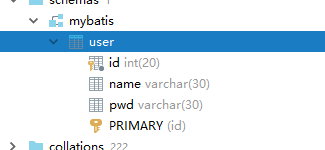
新建一个项目,拷贝之前的,测试实体类字段不一致的情况
public class User {
private int id;
private String name;
private String password;
}
测试出现问题

// select * from mybatis.user where id = #{id}
//类型处理器
// select id,name,pwd from mybatis.user where id = #{id}
解决方法:
-
起别名
<select id="getUserById" resultType="com.kuang.pojo.User"> select id,name,pwd as password from mybatis.user where id = #{id} </select>
5.2、resultMap
结果集映射
id name pwd
id name password
<!--结果集映射-->
<resultMap id="UserMap" type="User">
<!--column数据库中的字段,property实体类中的属性-->
<result column="id" property="id"/>
<result column="name" property="name"/>
<result column="pwd" property="password"/>
</resultMap>
<select id="getUserById" resultMap="UserMap">
select * from mybatis.user where id = #{id}
</select>
resultMap元素是 MyBatis 中最重要最强大的元素- ResultMap 的设计思想是,对于简单的语句根本不需要配置显式的结果映射,而对于复杂一点的语句只需要描述它们的关系就行了。
ResultMap最优秀的地方在于,虽然你已经对它相当了解了,但是根本就不需要显式地用到他们。
6、日志
6.1、日志工厂
如果一个数据库操作,出现了异常,我们需要排错。日志就是最好的助手!
曾经:sout 、debug
现在:日志工厂!

- SLF4J
- LOG4J 【掌握】
- LOG4J2
- JDK_LOGGING
- COMMONS_LOGGING
- STDOUT_LOGGING 【掌握】
- NO_LOGGING
在Mybatis中具体使用那个一日志实现,在设置中设定!
STDOUT_LOGGING标准日志输出
在mybatis核心配置文件中,配置我们的日志!
<settings>
<setting name="logImpl" value="STDOUT_LOGGING"/>
</settings>

6.2、Log4j
什么是Log4j?
- Log4j是Apache的一个开源项目,通过使用Log4j,我们可以控制日志信息输送的目的地是控制台、文件、GUI组件
- 我们也可以控制每一条日志的输出格式;
- 通过定义每一条日志信息的级别,我们能够更加细致地控制日志的生成过程。
- 通过一个配置文件来灵活地进行配置,而不需要修改应用的代码。
-
先导入log4j的包
<!-- https://mvnrepository.com/artifact/log4j/log4j --> <dependency> <groupId>log4j</groupId> <artifactId>log4j</artifactId> <version>1.2.17</version> </dependency> -
log4j.properties
#将等级为DEBUG的日志信息输出到console和file这两个目的地,console和file的定义在下面的代码 log4j.rootLogger=DEBUG,console,file #控制台输出的相关设置 log4j.appender.console = org.apache.log4j.ConsoleAppender log4j.appender.console.Target = System.out log4j.appender.console.Threshold=DEBUG log4j.appender.console.layout = org.apache.log4j.PatternLayout log4j.appender.console.layout.ConversionPattern=[%c]-%m%n #文件输出的相关设置 log4j.appender.file = org.apache.log4j.RollingFileAppender log4j.appender.file.File=./log/kuang.log log4j.appender.file.MaxFileSize=10mb log4j.appender.file.Threshold=DEBUG log4j.appender.file.layout=org.apache.log4j.PatternLayout log4j.appender.file.layout.ConversionPattern=[%p][%d{yy-MM-dd}][%c]%m%n #日志输出级别 log4j.logger.org.mybatis=DEBUG log4j.logger.java.sql=DEBUG log4j.logger.java.sql.Statement=DEBUG log4j.logger.java.sql.ResultSet=DEBUG log4j.logger.java.sql.PreparedStatement=DEBUG -
配置log4j为日志的实现
<settings> <setting name="logImpl" value=""/> </settings> -
Log4j的使用!,直接测试运行刚才的查询
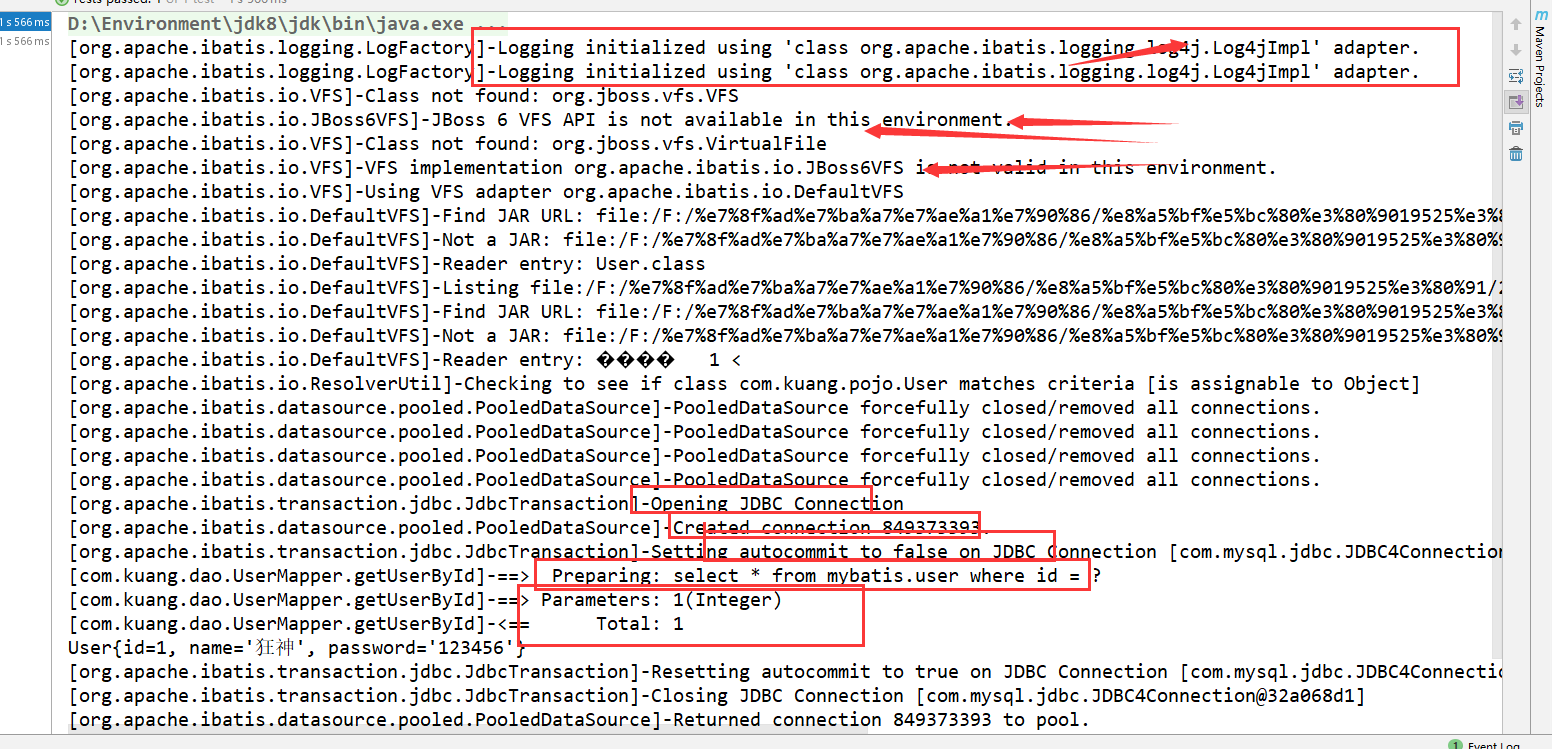
简单使用
可以代替sout进行使用
-
在要使用Log4j 的类中,导入包 import org.apache.log4j.Logger;
-
日志对象,参数为当前类的class
static Logger logger = Logger.getLogger(UserDaoTest.class); -
日志级别
logger.info("info:进入了testLog4j"); logger.debug("debug:进入了testLog4j"); logger.error("error:进入了testLog4j");
7、分页(sql层面分页、java层次分页)
思考:为什么要分页?
- 减少数据的处理量
7.1、使用Limit分页
语法:SELECT * from user limit startIndex,pageSize;
SELECT * from user limit 3; #[0,n]
使用Mybatis实现分页,核心SQL
-
接口
//分页 List<User> getUserByLimit(Map<String,Integer> map); -
Mapper.xml
<!--//分页--> <select id="getUserByLimit" parameterType="map" resultMap="UserMap"> select * from mybatis.user limit #{startIndex},#{pageSize} </select> -
测试
@Test public void getUserByLimit(){ SqlSession sqlSession = MybatisUtils.getSqlSession(); UserMapper mapper = sqlSession.getMapper(UserMapper.class); HashMap<String, Integer> map = new HashMap<String, Integer>(); map.put("startIndex",1); map.put("pageSize",2); List<User> userList = mapper.getUserByLimit(map); for (User user : userList) { System.out.println(user); } sqlSession.close(); }
7.2、RowBounds分页
不再使用SQL实现分页
-
接口
//分页2 List<User> getUserByRowBounds(); -
mapper.xml
<!--分页2--> <select id="getUserByRowBounds" resultMap="UserMap"> select * from mybatis.user </select> -
测试
@Test public void getUserByRowBounds(){ SqlSession sqlSession = MybatisUtils.getSqlSession(); //RowBounds实现 RowBounds rowBounds = new RowBounds(1, 2); //通过Java代码层面实现分页 List<User> userList = sqlSession.selectList("com.kuang.dao.UserMapper.getUserByRowBounds",null,rowBounds); for (User user : userList) { System.out.println(user); } sqlSession.close(); }
7.3、分页插件
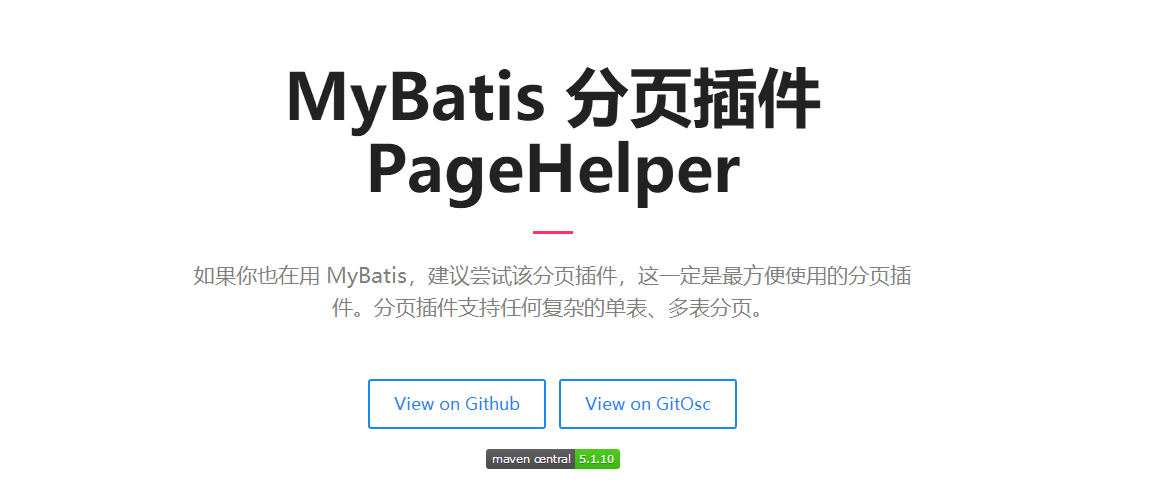
了解即可
8、使用注解开发
8.1、面向接口编程
- 大家之前都学过面向对象编程,也学习过接口,但在真正的开发中,很多时候我们会选择面向接口编程
- **根本原因 : 解耦 **
- 在一个面向对象的系统中,系统的各种功能是由许许多多的不同对象协作完成的。在这种情况下,各个对象内部是如何实现自己的,对系统设计人员来讲就不那么重要了;
- 而各个对象之间的协作关系则成为系统设计的关键。小到不同类之间的通信,大到各模块之间的交互,在系统设计之初都是要着重考虑的,这也是系统设计的主要工作内容。面向接口编程就是指按照这种思想来编程。
关于接口的理解
- 接口从更深层次的理解,应是定义(规范,约束)与实现(名实分离的原则)的分离。
- 接口的本身反映了系统设计人员对系统的抽象理解。
- 接口应有两类:
- 第一类是对一个个体的抽象,它可对应为一个抽象体(abstract class);
- 第二类是对一个个体某一方面的抽象,即形成一个抽象面(interface);
- 一个体有可能有多个抽象面。抽象体与抽象面是有区别的。
三个面向区别
- 面向对象是指,我们考虑问题时,以对象为单位,考虑它的属性及方法 .
- 面向过程是指,我们考虑问题时,以一个具体的流程(事务过程)为单位,考虑它的实现 .
- 接口设计与非接口设计是针对复用技术而言的,与面向对象(过程)不是一个问题.更多的体现就是对系统整体的架构
8.2、使用注解开发
-
注解在接口上实现
@Select("select * from user") List<User> getUsers(); -
需要再核心配置文件中绑定接口!
<!--绑定接口--> <mappers> <mapper class="com.kuang.dao.UserMapper"/> </mappers> -
测试
@Test public void test(){ //第一步:获得SqlSession对象 执行sql语句的对象 SqlSession sqlSession = MybatisUtils.getSqlSession(); // sqlSession.getMapper(UserMapper.class);返回一个可以执行UserMapper的对象 UserMapper mapper = sqlSession.getMapper(UserMapper.class); List<User> userList = mapper.getUsers(); for (User user : userList) { System.out.println(user); } //关闭SqlSession sqlSession.close() ; }
本质:反射机制实现
底层:动态代理!
8.3、CRUD
我们可以在工具类创建的时候实现自动提交事务!
public static SqlSession getSqlSession(){
return sqlSessionFactory.openSession(true);
}
编写接口,增加注解
public interface UserMapper {
@Select("select * from user")
List<User> getUsers();
// 方法存在多个参数,所有的参数前面必须加上 @Param("id")注解
@Select("select * from user where id = #{id}")
User getUserByID(@Param("id") int id);
@Insert("insert into user(id,name,pwd) values (#{id},#{name},#{password})")
int addUser(User user);
@Update("update user set name=#{name},pwd=#{password} where id = #{id}")
int updateUser(User user);
@Delete("delete from user where id = #{uid}")
int deleteUser(@Param("uid") int id);
}
测试类
【注意:我们必须要讲接口注册绑定到我们的核心配置文件中!】
关于@Param() 注解
- 基本类型的参数或者String类型,需要加上
- 引用类型不需要加
- 我们在SQL中引用的就是我们这里的 @Param() 中设定的属性名!
#{} ${} 区别
就是预编译和直接编译所使用的取值方式,预编译可以防止sql注入。
9、Lombok
-
java library
-
plugs
-
build tools
-
with one annotation your class
主要用户方便写实体(pojo)类
使用步骤:
-
在IDEA中安装Lombok插件!
-
在项目中导入lombok的jar包
<dependency> <groupId>org.projectlombok</groupId> <artifactId>lombok</artifactId> <version>1.18.10</version> </dependency> -
在实体类上加注解即可!
@Data @AllArgsConstructor @NoArgsConstructor
@Getter and @Setter
@FieldNameConstants
@ToString
@EqualsAndHashCode
@AllArgsConstructor, @RequiredArgsConstructor and @NoArgsConstructor
@Log, @Log4j, @Log4j2, @Slf4j, @XSlf4j, @CommonsLog, @JBossLog, @Flogger
@Data
@Builder
@Singular
@Delegate
@Value
@Accessors
@Wither
@SneakyThrows
说明:
@Data:无参构造,get、set、tostring、hashcode,equals
@AllArgsConstructor
@NoArgsConstructor
@EqualsAndHashCode
@ToString
@Getter
10、多对一处理与一对多处理
多对一:
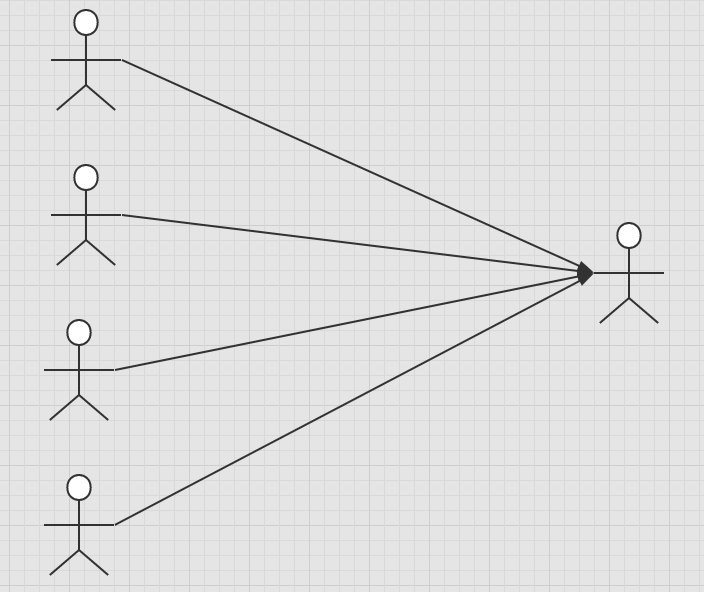
- 多个学生,对应一个老师
- 对于学生这边而言, 关联 .. 多个学生,关联一个老师 【多对一】 assocation
- 对于老师而言, 集合 , 一个老师,有很多学生 【一对多】 collection
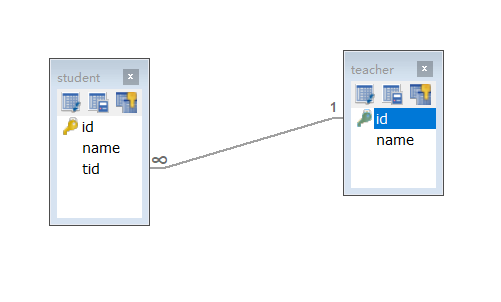
SQL:
CREATE TABLE `teacher` (
`id` INT(10) NOT NULL,
`name` VARCHAR(30) DEFAULT NULL,
PRIMARY KEY (`id`)
) ENGINE=INNODB DEFAULT CHARSET=utf8
INSERT INTO teacher(`id`, `name`) VALUES (1, '秦老师');
CREATE TABLE `student` (
`id` INT(10) NOT NULL,
`name` VARCHAR(30) DEFAULT NULL,
`tid` INT(10) DEFAULT NULL,
PRIMARY KEY (`id`),
KEY `fktid` (`tid`),
CONSTRAINT `fktid` FOREIGN KEY (`tid`) REFERENCES `teacher` (`id`)
) ENGINE=INNODB DEFAULT CHARSET=utf8
INSERT INTO `student` (`id`, `name`, `tid`) VALUES ('1', '小明', '1');
INSERT INTO `student` (`id`, `name`, `tid`) VALUES ('2', '小红', '1');
INSERT INTO `student` (`id`, `name`, `tid`) VALUES ('3', '小张', '1');
INSERT INTO `student` (`id`, `name`, `tid`) VALUES ('4', '小李', '1');
INSERT INTO `student` (`id`, `name`, `tid`) VALUES ('5', '小王', '1');
测试环境搭建
- 导入lombok
- 新建实体类 Teacher,Student
- 建立Mapper接口
- 建立Mapper.XML文件
- 在核心配置文件中绑定注册我们的Mapper接口或者文件!【方式很多,随心选】
- 测试查询是否能够成功!
按照查询嵌套处理
<!--
思路:
1. 查询所有的学生信息
2. 根据查询出来的学生的tid,寻找对应的老师! 子查询
-->
<select id="getStudent" resultMap="StudentTeacher">
select * from student
</select>
<resultMap id="StudentTeacher" type="Student">
<result property="id" column="id"/>
<result property="name" column="name"/>
<!--复杂的属性,我们需要单独处理 对象: association 集合: collection -->
<association property="teacher" column="tid" javaType="Teacher" select="getTeacher"/>
</resultMap>
<select id="getTeacher" resultType="Teacher">
select * from teacher where id = #{id}
</select>
按照结果嵌套处理(重点掌握)
<!--按照结果嵌套处理-->
<select id="getStudent2" resultMap="StudentTeacher2">
select s.id sid,s.name sname,t.name tname
from student s,teacher t
where s.tid = t.id;
</select>
<resultMap id="StudentTeacher2" type="Student">
<result property="id" column="sid"/>
<result property="name" column="sname"/>
<association property="teacher" javaType="Teacher">
<result property="name" column="tname"/>
</association>
</resultMap>
回顾Mysql 多对一查询方式:
- 子查询
- 联表查询
一对多处理
比如:一个老师拥有多个学生!
对于老师而言,就是一对多的关系!
环境搭建
- 环境搭建,和刚才一样
实体类
@Data
public class Student {
private int id;
private String name;
private int tid;
}
@Data
public class Teacher {
private int id;
private String name;
//一个老师拥有多个学生
private List<Student> students;
}
按照结果嵌套处理(重点掌握)
<!--按结果嵌套查询-->
<select id="getTeacher" resultMap="TeacherStudent">
select s.id sid, s.name sname, t.name tname,t.id tid
from student s,teacher t
where s.tid = t.id and t.id = #{tid}
</select>
<resultMap id="TeacherStudent" type="Teacher">
<result property="id" column="tid"/>
<result property="name" column="tname"/>
<!--复杂的属性,我们需要单独处理 对象: association 集合: collection
javaType="" 指定属性的类型!
集合中的泛型信息,我们使用ofType获取
-->
<collection property="students" ofType="Student">
<result property="id" column="sid"/>
<result property="name" column="sname"/>
<result property="tid" column="tid"/>
</collection>
</resultMap>
按照查询嵌套处理
<select id="getTeacher2" resultMap="TeacherStudent2">
select * from mybatis.teacher where id = #{tid}
</select>
<resultMap id="TeacherStudent2" type="Teacher">
<collection property="students" javaType="ArrayList" ofType="Student" select="getStudentByTeacherId" column="id"/>
</resultMap>
<select id="getStudentByTeacherId" resultType="Student">
select * from mybatis.student where tid = #{tid}
</select>
小结
- 关联 - association 【多对一】
- 集合 - collection 【一对多】
- javaType & ofType
- JavaType 用来指定实体类中属性的类型
- ofType 用来指定映射到List或者集合中的 pojo类型,泛型中的约束类型!
注意点:
- 保证SQL的可读性,尽量保证通俗易懂
- 注意一对多和多对一中,属性名和字段的问题!
- 如果问题不好排查错误,可以使用日志 , 建议使用 Log4j
11、动态 SQL(重点)
什么是动态SQL:动态SQL就是指根据不同的条件生成不同的SQL语句
利用动态 SQL 这一特性可以彻底摆脱这种痛苦。
动态 SQL 元素和 JSTL 或基于类似 XML 的文本处理器相似。在 MyBatis 之前的版本中,有很多元素需要花时间了解。MyBatis 3 大大精简了元素种类,现在只需学习原来一半的元素便可。MyBatis 采用功能强大的基于 OGNL 的表达式来淘汰其它大部分元素。
if
choose (when, otherwise)
trim (where, set)
foreach
搭建环境
CREATE TABLE `blog` (
`id` varchar(50) NOT NULL COMMENT '博客id',
`title` varchar(100) NOT NULL COMMENT '博客标题',
`author` varchar(30) NOT NULL COMMENT '博客作者',
`create_time` datetime NOT NULL COMMENT '创建时间',
`views` int(30) NOT NULL COMMENT '浏览量'
) ENGINE=InnoDB DEFAULT CHARSET=utf8
创建一个基础工程
-
导包
-
编写配置文件
-
编写实体类
@Data public class Blog { private int id; private String title; private String author; private Date createTime; private int views; } -
编写实体类对应Mapper接口 和 Mapper.XML文件
IF
<select id="queryBlogIF" parameterType="map" resultType="blog">
select * from mybatis.blog where 1=1
<if test="title != null">
and title = #{title}
</if>
<if test="author != null">
and author = #{author}
</if>
</select>
choose (when, otherwise)
<select id="queryBlogChoose" parameterType="map" resultType="blog">
select * from mybatis.blog
<where>
<choose>
<when test="title != null">
title = #{title}
</when>
<when test="author != null">
and author = #{author}
</when>
<otherwise>
and views = #{views}
</otherwise>
</choose>
</where>
</select>
trim (where,set)
select * from mybatis.blog
<where>
<if test="title != null">
title = #{title}
</if>
<if test="author != null">
and author = #{author}
</if>
</where>
<update id="updateBlog" parameterType="map">
update mybatis.blog
<set>
<if test="title != null">
title = #{title},
</if>
<if test="author != null">
author = #{author}
</if>
</set>
where id = #{id}
</update>
所谓的动态SQL,本质还是SQL语句 , 只是我们可以在SQL层面,去执行一个逻辑代码
if
where , set , choose ,when
SQL片段
有的时候,我们可能会将一些功能的部分抽取出来,方便复用!
-
使用SQL标签抽取公共的部分
<sql id="if-title-author"> <if test="title != null"> title = #{title} </if> <if test="author != null"> and author = #{author} </if> </sql> -
在需要使用的地方使用Include标签引用即可
<select id="queryBlogIF" parameterType="map" resultType="blog"> select * from mybatis.blog <where> <include refid="if-title-author"></include> </where> </select>
注意事项:
- 最好基于单表来定义SQL片段!
- 不要存在where标签
Foreach
select * from user where 1=1 and
<foreach item="id" collection="ids"
open="(" separator="or" close=")">
#{id}
</foreach>
(id=1 or id=2 or id=3)


<!--
select * from mybatis.blog where 1=1 and (id=1 or id = 2 or id=3)
我们现在传递一个万能的map , 这map中可以存在一个集合!
-->
<select id="queryBlogForeach" parameterType="map" resultType="blog">
select * from mybatis.blog
<where>
<foreach collection="ids" item="id" open="and (" close=")" separator="or">
id = #{id}
</foreach>
</where>
</select>
动态SQL就是在拼接SQL语句,我们只要保证SQL的正确性,按照SQL的格式,去排列组合就可以了
建议:
- 现在Mysql中写出完整的SQL,再对应的去修改成为我们的动态SQL实现通用即可!
12、缓存 (了解)
12.1、简介
查询 : 连接数据库 ,耗资源!
一次查询的结果,给他暂存在一个可以直接取到的地方!--> 内存 : 缓存
我们再次查询相同数据的时候,直接走缓存,就不用走数据库了
- 什么是缓存 [ Cache ]?
- 存在内存中的临时数据。
- 将用户经常查询的数据放在缓存(内存)中,用户去查询数据就不用从磁盘上(关系型数据库数据文件)查询,从缓存中查询,从而提高查询效率,解决了高并发系统的性能问题。
- 为什么使用缓存?
- 减少和数据库的交互次数,减少系统开销,提高系统效率。
- 什么样的数据能使用缓存?
- 经常查询并且不经常改变的数据。【可以使用缓存】
12.2、Mybatis缓存
-
MyBatis包含一个非常强大的查询缓存特性,它可以非常方便地定制和配置缓存。缓存可以极大的提升查询效率。
-
MyBatis系统中默认定义了两级缓存:
一级缓存
和
二级缓存
- 默认情况下,只有一级缓存开启。(SqlSession级别的缓存,也称为本地缓存)
- 二级缓存需要手动开启和配置,他是基于namespace级别的缓存。
- 为了提高扩展性,MyBatis定义了缓存接口Cache。我们可以通过实现Cache接口来自定义二级缓存
12.3、一级缓存
- 一级缓存也叫本地缓存: SqlSession
- 与数据库同一次会话期间查询到的数据会放在本地缓存中。
- 以后如果需要获取相同的数据,直接从缓存中拿,没必须再去查询数据库;
测试步骤:
- 开启日志!
- 测试在一个Sesion中查询两次相同记录
- 查看日志输出

缓存失效的情况:
-
查询不同的东西
-
增删改操作,可能会改变原来的数据,所以必定会刷新缓存!
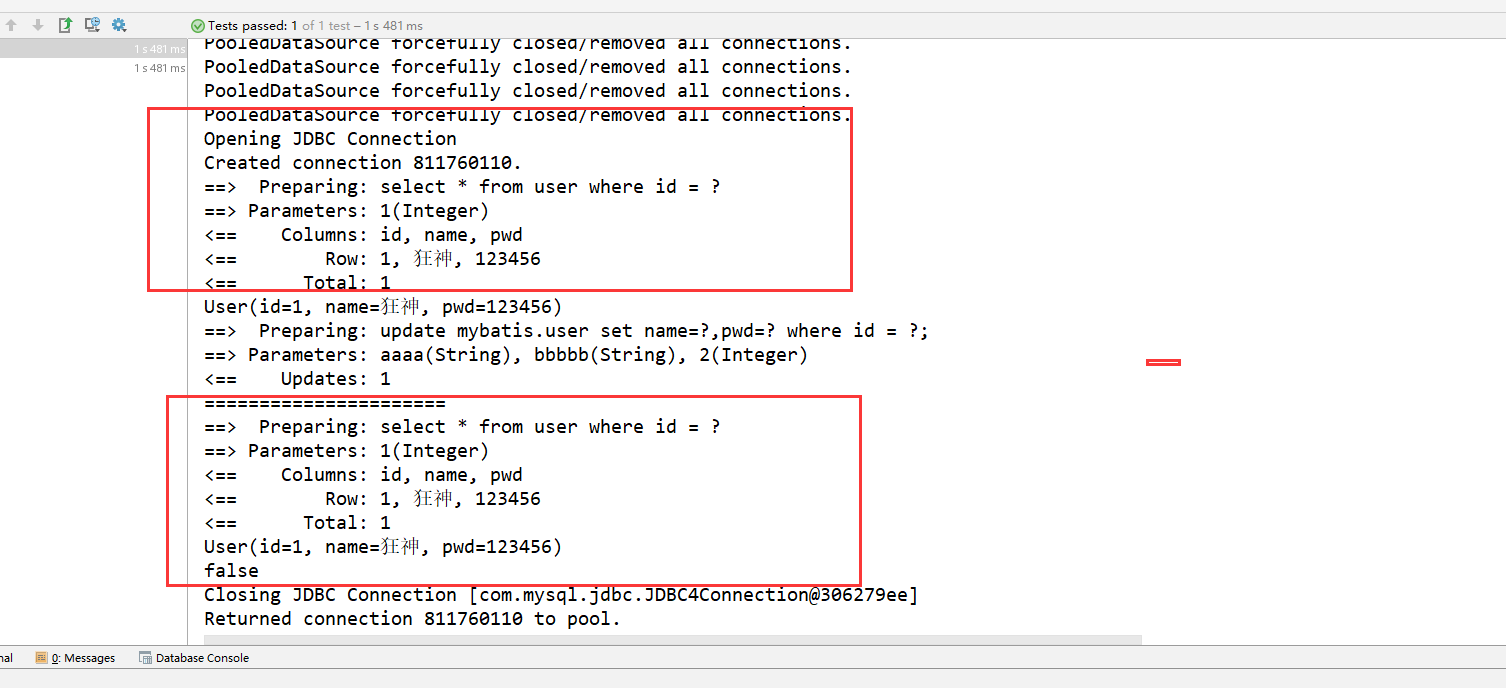
-
查询不同的Mapper.xml
-
手动清理缓存!
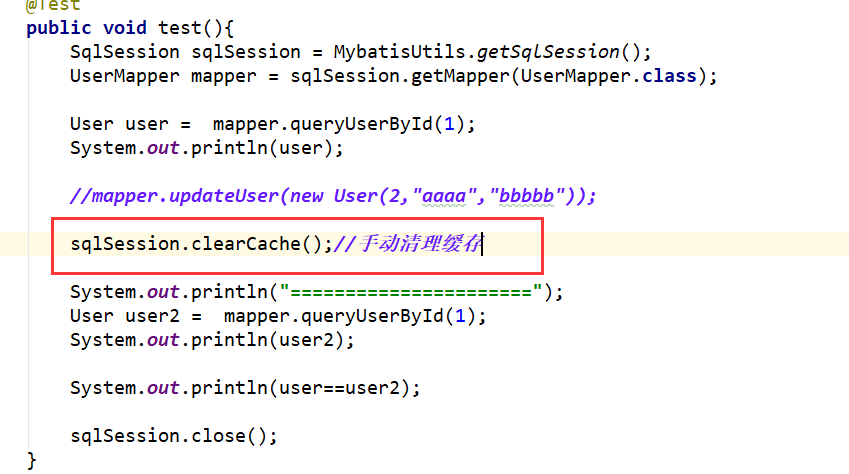
小结:一级缓存默认是开启的,只在一次SqlSession中有效,也就是拿到连接到关闭连接这个区间段!
一级缓存就是一个Map。
12.4、二级缓存
- 二级缓存也叫全局缓存,一级缓存作用域太低了,所以诞生了二级缓存
- 基于namespace级别的缓存,一个名称空间(一个mapper.xml文件),对应一个二级缓存;
- 工作机制
- 一个会话查询一条数据,这个数据就会被放在当前会话的一级缓存中;
- 如果当前会话关闭了,这个会话对应的一级缓存就没了;但是我们想要的是,会话关闭了,一级缓存中的数据被保存到二级缓存中;
- 新的会话查询信息,就可以从二级缓存中获取内容;
- 不同的mapper查出的数据会放在自己对应的缓存(map)中;
步骤:
-
开启全局缓存
<!--显示的开启全局缓存--> <setting name="cacheEnabled" value="true"/> -
在要使用二级缓存的Mapper中开启
<!--在当前Mapper.xml中使用二级缓存--> <cache/>也可以自定义参数
<!--在当前Mapper.xml中使用二级缓存--> <cache eviction="FIFO" flushInterval="60000" size="512" readOnly="true"/> -
测试
-
问题:我们需要将实体类序列化!否则就会报错!
Caused by: java.io.NotSerializableException: com.kuang.pojo.User
-
小结:
- 只要开启了二级缓存,在同一个Mapper下就有效
- 所有的数据都会先放在一级缓存中;
- 只有当会话提交,或者关闭的时候,才会提交到二级缓冲中!
12.5、缓存原理
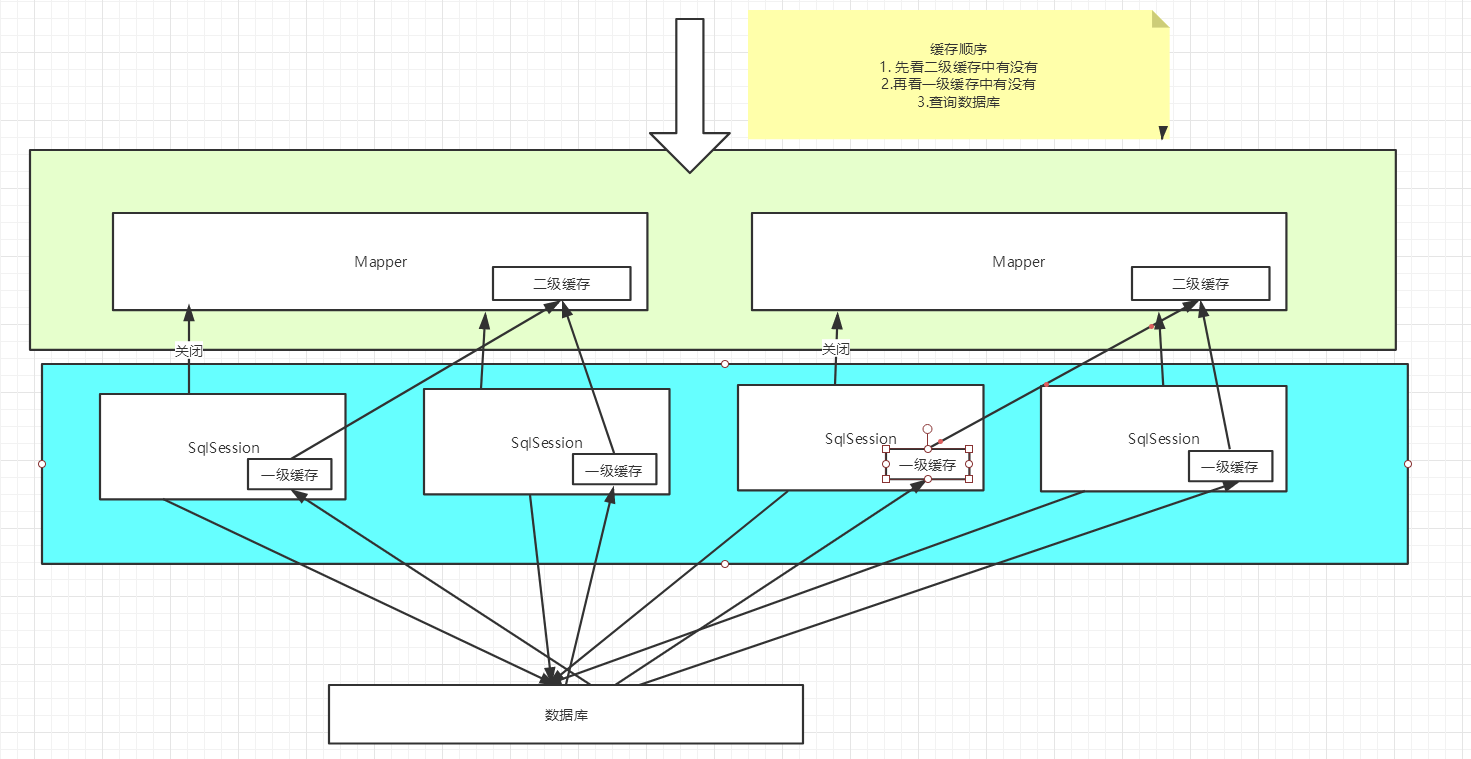
12.6、自定义缓存-ehcache
Ehcache是一种广泛使用的开源Java分布式缓存。主要面向通用缓存
要在程序中使用ehcache,先要导包!
<!-- https://mvnrepository.com/artifact/org.mybatis.caches/mybatis-ehcache -->
<dependency>
<groupId>org.mybatis.caches</groupId>
<artifactId>mybatis-ehcache</artifactId>
<version>1.1.0</version>
</dependency>
在mapper中指定使用我们的ehcache缓存实现!
<!--在当前Mapper.xml中使用二级缓存-->
<cache type="org.mybatis.caches.ehcache.EhcacheCache"/>
ehcache.xml
<?xml version="1.0" encoding="UTF-8"?>
<ehcache xmlns:xsi="http://www.w3.org/2001/XMLSchema-instance"
xsi:noNamespaceSchemaLocation="http://ehcache.org/ehcache.xsd"
updateCheck="false">
<!--
diskStore:为缓存路径,ehcache分为内存和磁盘两级,此属性定义磁盘的缓存位置。参数解释如下:
user.home – 用户主目录
user.dir – 用户当前工作目录
java.io.tmpdir – 默认临时文件路径
-->
<diskStore path="./tmpdir/Tmp_EhCache"/>
<defaultCache
eternal="false"
maxElementsInMemory="10000"
overflowToDisk="false"
diskPersistent="false"
timeToIdleSeconds="1800"
timeToLiveSeconds="259200"
memoryStoreEvictionPolicy="LRU"/>
<cache
name="cloud_user"
eternal="false"
maxElementsInMemory="5000"
overflowToDisk="false"
diskPersistent="false"
timeToIdleSeconds="1800"
timeToLiveSeconds="1800"
memoryStoreEvictionPolicy="LRU"/>
<!--
defaultCache:默认缓存策略,当ehcache找不到定义的缓存时,则使用这个缓存策略。只能定义一个。
-->
<!--
name:缓存名称。
maxElementsInMemory:缓存最大数目
maxElementsOnDisk:硬盘最大缓存个数。
eternal:对象是否永久有效,一但设置了,timeout将不起作用。
overflowToDisk:是否保存到磁盘,当系统当机时
timeToIdleSeconds:设置对象在失效前的允许闲置时间(单位:秒)。仅当eternal=false对象不是永久有效时使用,可选属性,默认值是0,也就是可闲置时间无穷大。
timeToLiveSeconds:设置对象在失效前允许存活时间(单位:秒)。最大时间介于创建时间和失效时间之间。仅当eternal=false对象不是永久有效时使用,默认是0.,也就是对象存活时间无穷大。
diskPersistent:是否缓存虚拟机重启期数据 Whether the disk store persists between restarts of the Virtual Machine. The default value is false.
diskSpoolBufferSizeMB:这个参数设置DiskStore(磁盘缓存)的缓存区大小。默认是30MB。每个Cache都应该有自己的一个缓冲区。
diskExpiryThreadIntervalSeconds:磁盘失效线程运行时间间隔,默认是120秒。
memoryStoreEvictionPolicy:当达到maxElementsInMemory限制时,Ehcache将会根据指定的策略去清理内存。默认策略是LRU(最近最少使用)。你可以设置为FIFO(先进先出)或是LFU(较少使用)。
clearOnFlush:内存数量最大时是否清除。
memoryStoreEvictionPolicy:可选策略有:LRU(最近最少使用,默认策略)、FIFO(先进先出)、LFU(最少访问次数)。
FIFO,first in first out,这个是大家最熟的,先进先出。
LFU, Less Frequently Used,就是上面例子中使用的策略,直白一点就是讲一直以来最少被使用的。如上面所讲,缓存的元素有一个hit属性,hit值最小的将会被清出缓存。
LRU,Least Recently Used,最近最少使用的,缓存的元素有一个时间戳,当缓存容量满了,而又需要腾出地方来缓存新的元素的时候,那么现有缓存元素中时间戳离当前时间最远的元素将被清出缓存。
-->
</ehcache>
Redis数据库来做缓存! K-V
参考狂神说Mybatis





【推荐】国内首个AI IDE,深度理解中文开发场景,立即下载体验Trae
【推荐】编程新体验,更懂你的AI,立即体验豆包MarsCode编程助手
【推荐】抖音旗下AI助手豆包,你的智能百科全书,全免费不限次数
【推荐】轻量又高性能的 SSH 工具 IShell:AI 加持,快人一步
· 被坑几百块钱后,我竟然真的恢复了删除的微信聊天记录!
· 【自荐】一款简洁、开源的在线白板工具 Drawnix
· 没有Manus邀请码?试试免邀请码的MGX或者开源的OpenManus吧
· 园子的第一款AI主题卫衣上架——"HELLO! HOW CAN I ASSIST YOU TODAY
· 无需6万激活码!GitHub神秘组织3小时极速复刻Manus,手把手教你使用OpenManus搭建本